light CADILLAC CATERA 1998 1.G Owners Manual
[x] Cancel search | Manufacturer: CADILLAC, Model Year: 1998, Model line: CATERA, Model: CADILLAC CATERA 1998 1.GPages: 346, PDF Size: 19.13 MB
Page 12 of 346

Downloaded from www.Manualslib.com manuals search engine Vehicle Symbols
These are some of the symbols you may find on your vehicle.
For example,
these symbols
are used on
an
original battery:
POSSIBLE A
CAUTION
INJURY
PROTECT EYES BY
SHIELDING
CAUSTIC
ACID COULD BAlTERY
CAUSE
BURNS
AVOID
SPARKS
OR
FLAMES
SPARK
OR ,\I/,
COULD FLAME
EXPLODE BAllERY
These symbols
are important
for you and
your passengers
whenever your
vehicle is
driven:
DOOR LOCK
UNLOCK
FASTEN SEAT
BELTS
POWER
WINDOW
These symbols
have to do with
your lamps:
SIGNALS e e
TURN
FOG LAMPS
$0
These symbols
are on some
of
your controls:
WINDSHIELD
DEFROSTER
WINDOW
DEFOGGER
VENTILATING FAN
These symbols
are used on
warning and indicator lights:
COOLANT
TEMP
-
CHARGING I-1
BAllERY
SYSTEM
BRAKE
(0)
COOLANT a
ENGINE OIL e,
PRESSURE
ANTI-LOCK
(e)
BRAKES
Here are some other symbols
you may see:
FUSE
LIGHTER
I
HORN b
SPEAKER
b
FUEL la
Page 19 of 346
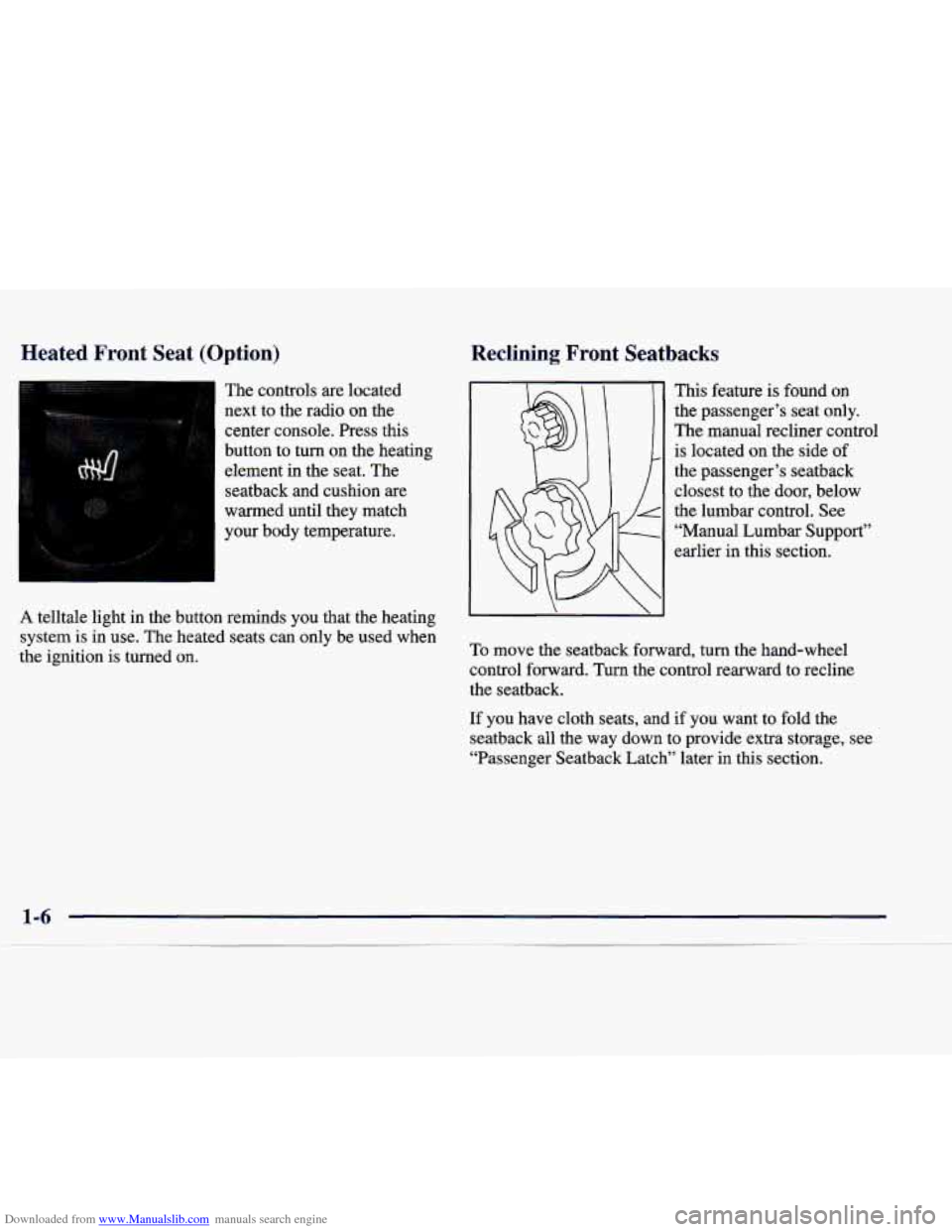
Downloaded from www.Manualslib.com manuals search engine Heated Front Seat (Option)
‘1
The controls are located
next to the radio on the
center console. Press this
button to turn on the heating
element in the seat. The
seatback and cushion are
warmed until they match
your body temperature.
A telltale light in the button reminds you that the heating
system is in use. The heated seats can only be used when
the ignition
is turned on.
Reclining Front Seatbacks
This feature is found on
the passenger’s seat only.
The manual recliner control
is located on the side
of
the passenger’s seatback
closest to the door, below
the lumbar control. See
“Manual Lumbar
Support’’
earlier in this section.
To move the seatback forward, turn the hand-wheel
control forward. Turn the control rearward to recline the seatback.
If
you have cloth seats, and if you want to fold the
seatback all the way down to provide extra storage, see
“Passenger Seatback Latch” later in this section.
Page 26 of 346

Downloaded from www.Manualslib.com manuals search engine Heated Rear Seat (Option)
The heated rear seat
controls are located at the
rear
of the center console
under the air outlets. Press
the button once
to turn on
the heating system and
press the button again to
turn the system off.
A telltale light in the button indicates the system is in
use. The heated seats can only be used when the ignition
is turned on. The heating system shuts off automatically
when the ignition is turned off.
Safety Belts: They’re for Everyone
This part of the manual tells you how to use safety belts
properly. It also tells you some things you should not do
with safety belts.
And it explains the air bag system.
I
A CAUTION:
I
Don’t let anyone ride where he or she can’t wear
a safety belt properly. If you are in a crash and
you’re not wearing
a safety belt, your injuries
can be much worse. You can hit things inside the
vehicle or be ejected from it. You can be seriously
injured or killed. In the same crash, you might
not be if you are buckled up, Always fasten your
safety belt, and check that your passengers’ belts
are fastened properly
too,
Page 27 of 346
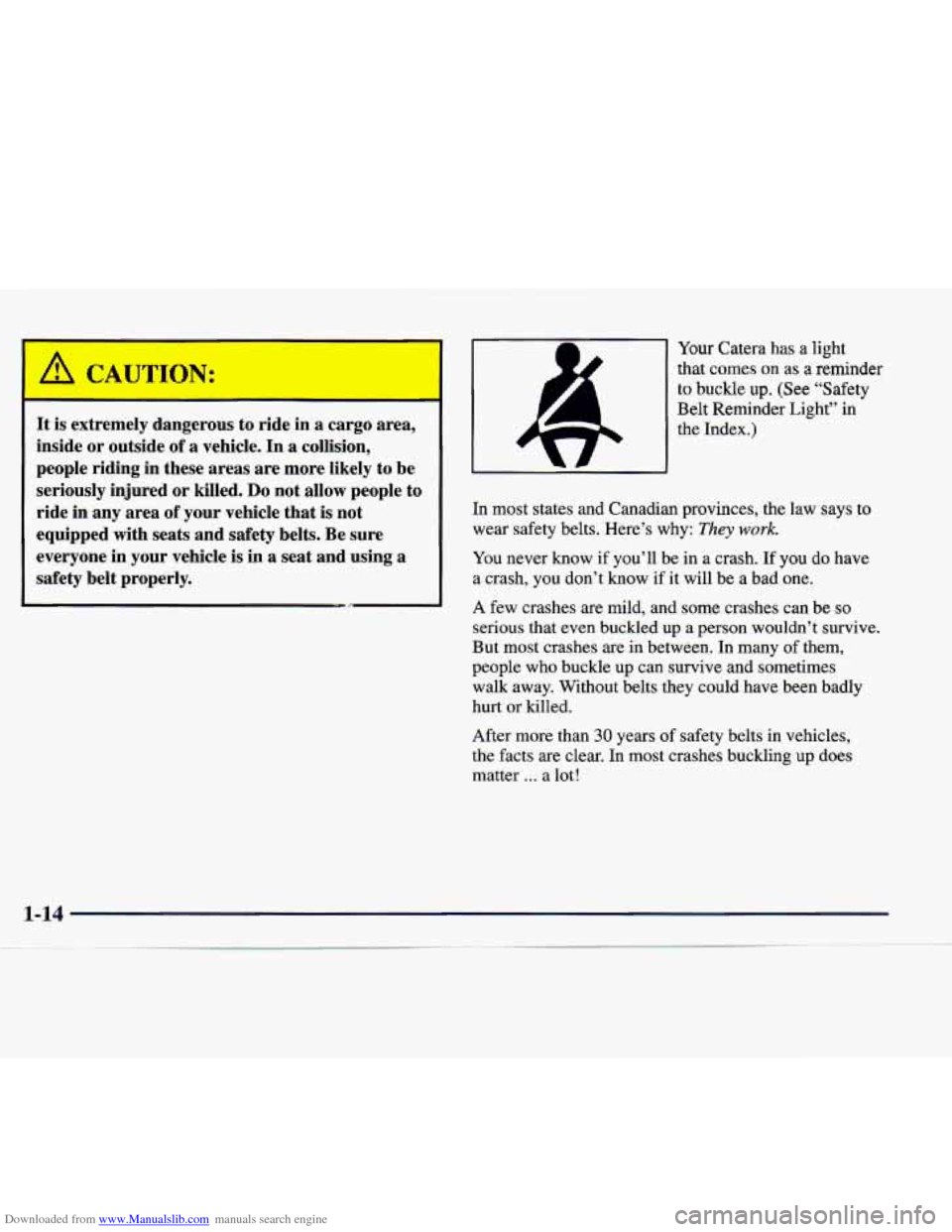
Downloaded from www.Manualslib.com manuals search engine It is extremely dangerous to ride in a cargo area,
inside or outside of
a vehicle. In a collision,
people riding in these areas are more likely to be
seriously injured
or killed. Do not allow people to
ride in any area of your vehicle that is not
equipped with seats and safety belts. Be sure
everyone in your vehicle is in
a seat and using a
safety belt properly.
Your Catera has a light
that comes on as
a reminder
to buckle
up. (See “Safety
Belt Reminder Light” in
the Index.)
In most states and Canadian provinces, the law says to
wear safety belts. Here’s why:
They work.
You never know if you’ll be in a crash. If you do have
a crash, you don’t know if it will be a bad one.
A few crashes are mild, and some crashes can be so
serious that even buckled up a person wouldn’t survive.
But most crashes are in between.
In many of them,
people who buckle
up can survive and sometimes
walk away. Without belts they could have been badly
hurt or killed.
After more than
30 years of safety belts in vehicles,
the facts are clear. In most crashes buckling up does
matter
... a lot!
Page 32 of 346
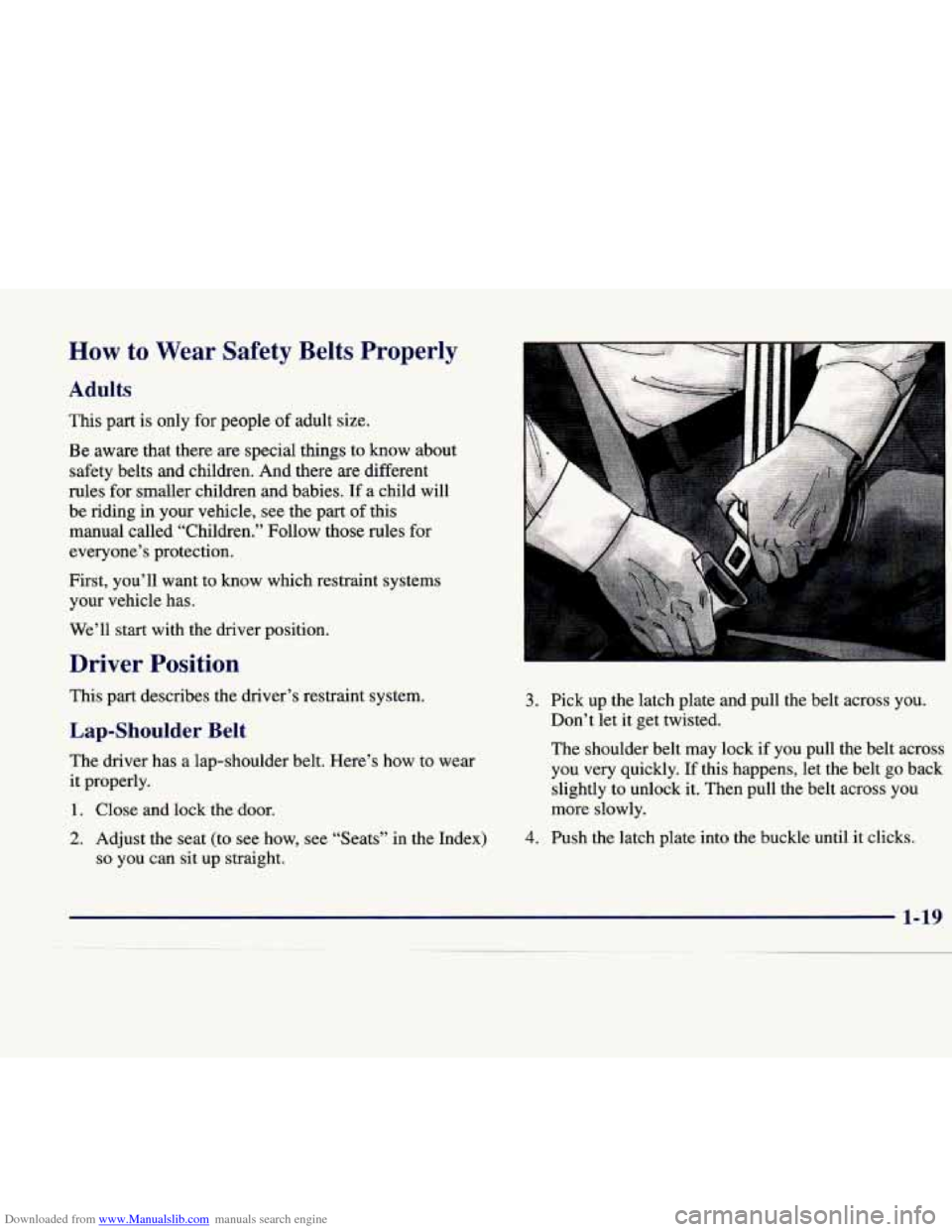
Downloaded from www.Manualslib.com manuals search engine How to Wear Safety Belts Properly
Adults
This part is only for people of adult size.
Be aware that there are special things to know about
safety belts and children. And there
are different
rules for smaller children and babies.
If a child will
be riding in your vehicle, see the part
of this
manual called “Children.” Follow those rules for
everyone’s protection.
First, you’ll want to know which restraint systems
your vehicle has.
We’ll start with the driver position.
Driver Position
This part describes the driver’s restraint system.
Lap-Shoulder Belt
The driver has a lap-shoulder belt. Here’s how to wear
it properly.
1. Close and lock the door.
2. Adjust the seat (to see how, see “Seats” in the Index)
so you can sit up straight.
A
3.
4.
Pick up the latch plate and pull the belt across you.
Don’t let it get twisted.
The shoulder belt may lock if you pull the belt across
you very quickly. If this happens, let the belt
go back
slightly to unlock it. Then pull the belt across you
more slowly.
Push the latch plate into the buckle until it clicks.
1-19
Page 43 of 346
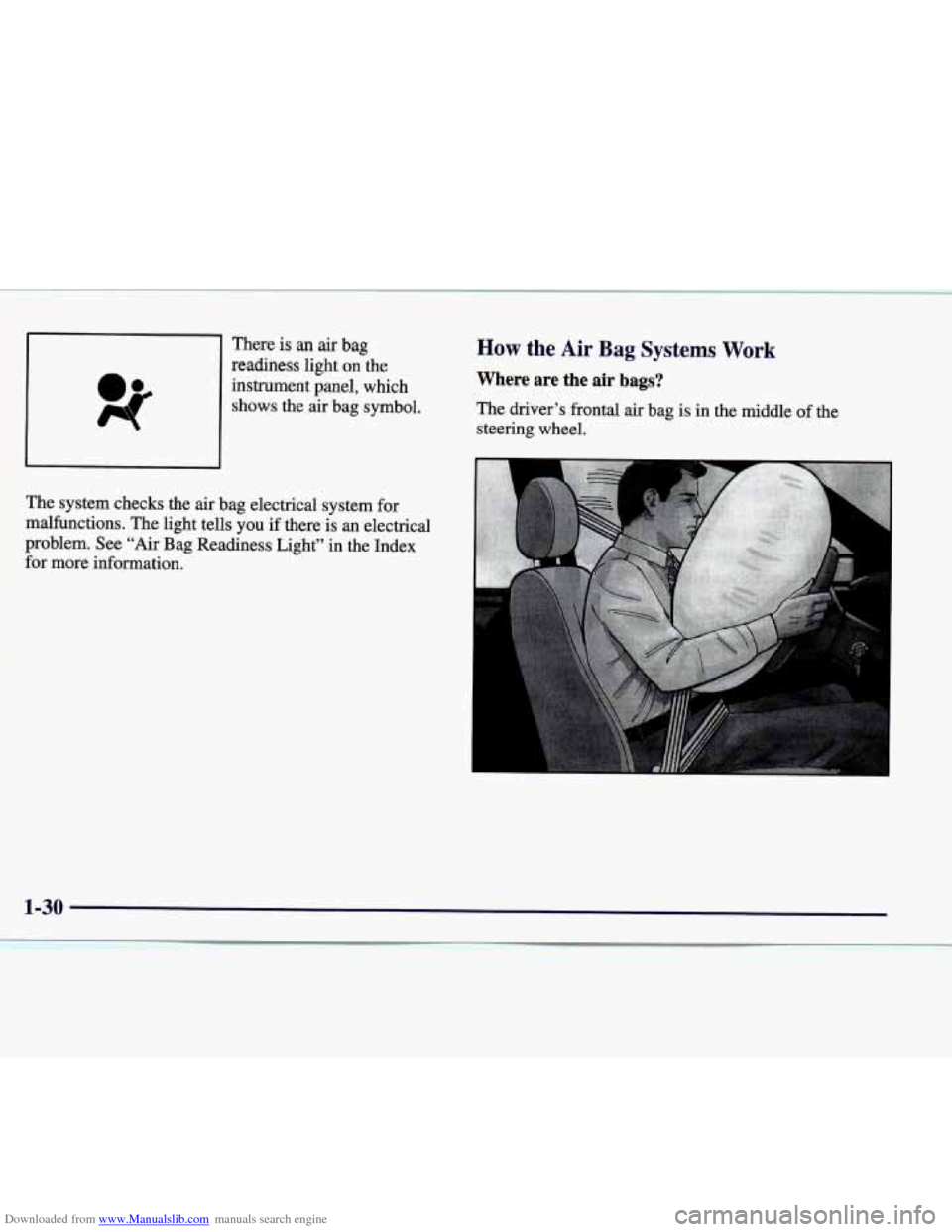
Downloaded from www.Manualslib.com manuals search engine I There is an air bag
readiness light on-the
instrument panel, which
shows the air bag symbol.
The system checks the
air bag electrical system for
malfunctions. The light tells you if there
is an electrical
problem. See “Air Bag Readiness Light” in
the Index
for more information.
How the Air Bag Systems Work
Where are the air bags?
The driver’s frontal air bag is in the middle of the
steering wheel.
1-30
Page 49 of 346

Downloaded from www.Manualslib.com manuals search engine Rear Seat Passengers
It’s very important for rear seat passengers to buckle up!
Accident statistics show that unbelted people in the rear
seat are hurt more often
in crashes than those who are
wearing safety belts.
Rear passengers who aren’t safety belted can be thrown
out of the vehicle
in a crash. And they can strike others
in the vehicle who
are wearing safety belts.
Rear Seat Passenger Positions
Lap-Shoulder Belt
All three rear seating positions have lap-shoulder belts.
Here’s how to wear one properly.
1. Pick up the latch plate and pull the belt across you.
Don’t let it get twisted.
The shoulder belt may lock
if you pull the belt across
you very quickly. If this happens, let the belt go back
slightly to unlock it. Then pull the belt across you
more slowly.
1-36
Page 69 of 346

Downloaded from www.Manualslib.com manuals search engine Safety Belt Extender
If the vehicle’s safety belt will fasten around you, you
should use it.
But if a safety belt isn’t long enough to fasten, your
dealer will order you an extender. It’s free. When you go
in to order it, take the heaviest coat you will wear,
so the
extender will be long enough for you. The extender will
be just for you, and just for the seat in your vehicle that
you choose. Don’t let someone else use it, and use it
only for the seat
it is made to fit. To wear it, just attach it
to the regular safety belt.
Checking Your Restraint Systems
Now and then, make sure the safety belt reminder light
and all your belts, buckles, latch plates, retractors and
anchorages are working properly. Look for any other
loose or damaged safety belt system parts. If you see
anything that might keep a safety belt system from
doing its job, have
it repaired.
Torn or frayed safety belts may not protect you in a
crash. They can rip apart under impact forces. If a belt
is torn or frayed, get a new one right away.
Also look for any opened
or broken air bag covers, and
have them repaired or replaced. (The air bag system
does not need regular maintenance.)
Page 72 of 346
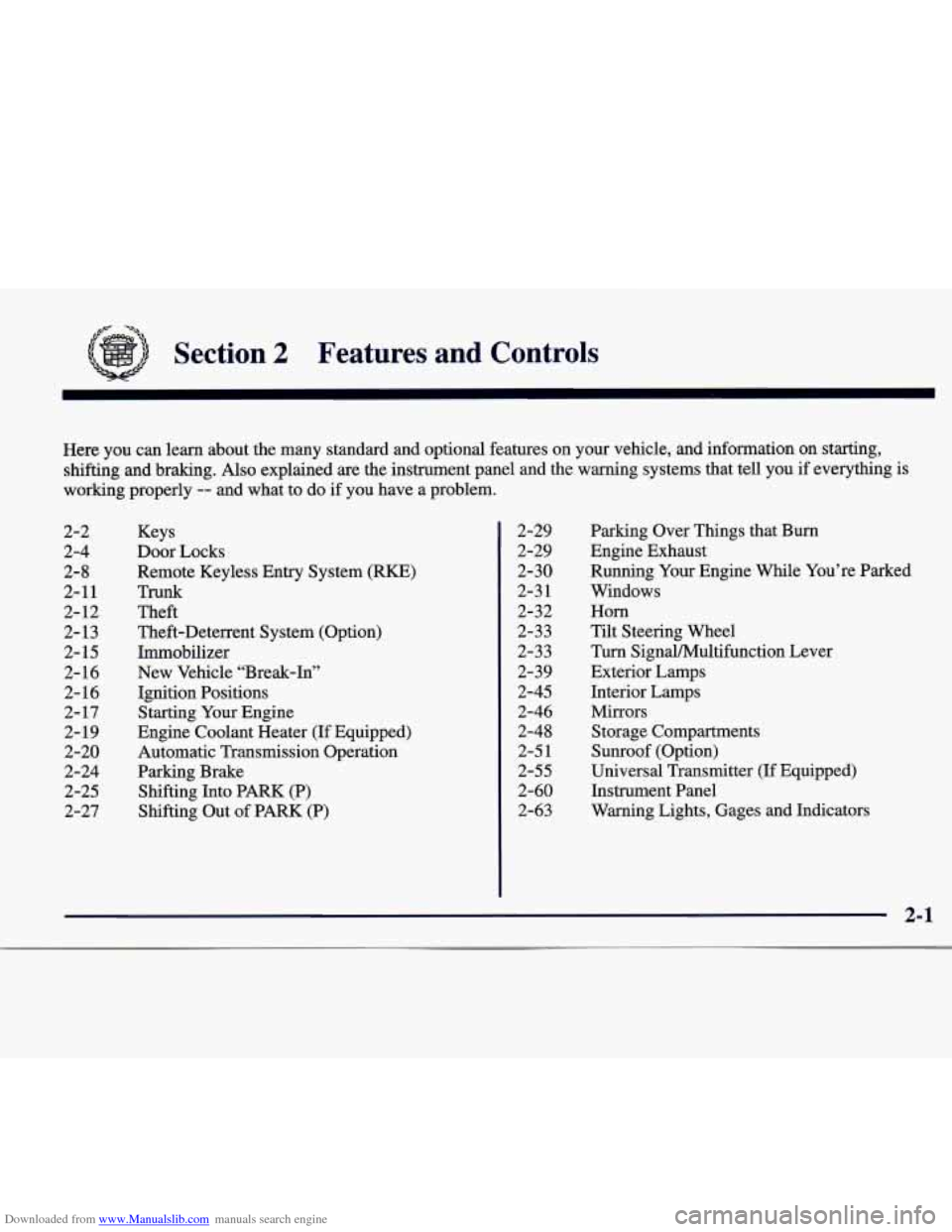
Downloaded from www.Manualslib.com manuals search engine Section 2 Features and Controls
Here you can learn about the many standard and optional features on your vehicle, and information on starting,
shifting and braking. Also explained
are the instrument panel and the warning systems that tell you if everything is
working properly
-- and what to do if you have a problem.
2-2
2-4 2-
8
2-11
2- 12
2- 13
2- 15
2- 16
2- 16
2- 17
2-19
2-20
2-24
2-25
2-27 Keys
Door Locks
Remote Keyless Entry System (RKE)
Trunk
Theft
Theft-Deterrent System (Option)
Immobilizer
New Vehicle “Break-In”
Ignition Positions Starting
Your Engine
Engine Coolant Heater (If Equipped)
Automatic Transmission Operation
Parking Brake Shifting Into PARK (P)
Shifting Out of PARK
(P)
2-29
2-29
2-30
2-3
1
2-32
2-33
2-33
2-39 2-45
2-46
2-48
2-5
1
2-55
2-60
2-63 Parking
Over Things that Burn
Engine Exhaust
Running
Your Engine While You’re Parked
Windows
Horn
Tilt Steering Wheel
Turn SignaVMultifunction Lever
Exterior Lamps
Interior Lamps
Mirrors
Storage Compartments
Sunroof (Option)
Universal Transmitter (If Equipped)
Instrument Panel
Warning Lights, Gages and Indicators
2-1
Page 84 of 346
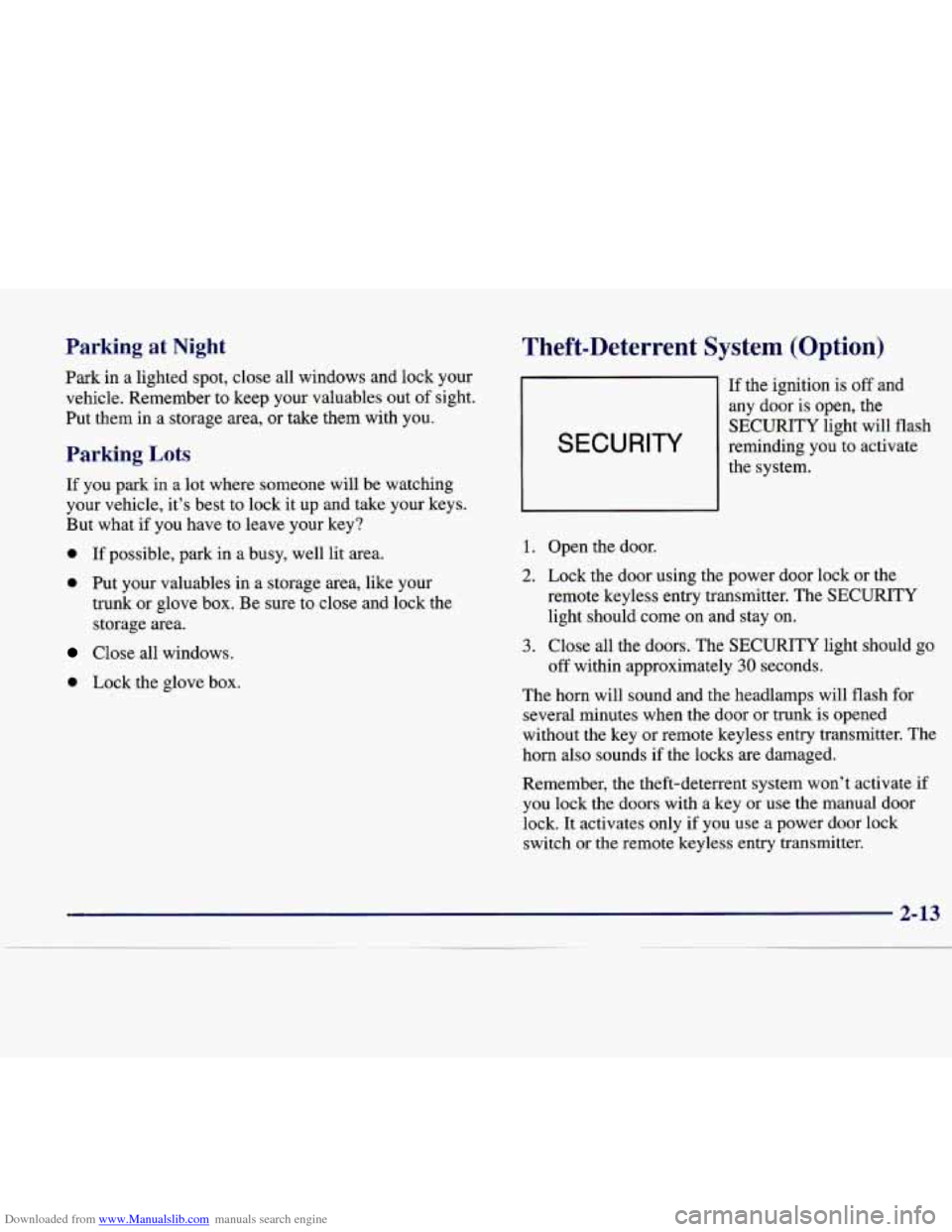
Downloaded from www.Manualslib.com manuals search engine Parking at Night
Park in a lighted spot, close all windows and lock your
vehicle. Remember to keep your valuables out of sight.
Put them in a storage area,
or take them with you.
Parking Lots
If you park in a lot where someone will be watching
your vehicle, it’s best to lock
it up and take your keys.
But what if you have to leave your key?
0 If possible, park in a busy, well lit area.
0 Put your valuables in a storage area, like your
trunk or glove box. Be sure to close and lock the
storage area.
Close all windows.
0 Lock the glove box.
Theft-Deterrent System (Option)
SECURITY
If the ignition is off and
any door
is open, the
SECURITY light will flash
reminding you to activate
the system.
1. Open the door.
2. Lock the door using the power door lock or the
remote keyless entry transmitter. The SECURITY
light should come
on and stay on.
3. Close all the doors. The SECURITY light should go
The horn will sound and the headlarr will flash
for
several minutes when the door or trunK
is opened
without the key or remote keyless entry transmitter. The
horn also sounds if the locks are damaged.
Remember, the theft-deterrent system won’t activate if
you lock the doors with
a key or use the manual door
lock. It activates only if you use
a power door lock
switch
or the remote keyless entry transmitter.
off within approximately
30 seconds.
~ -